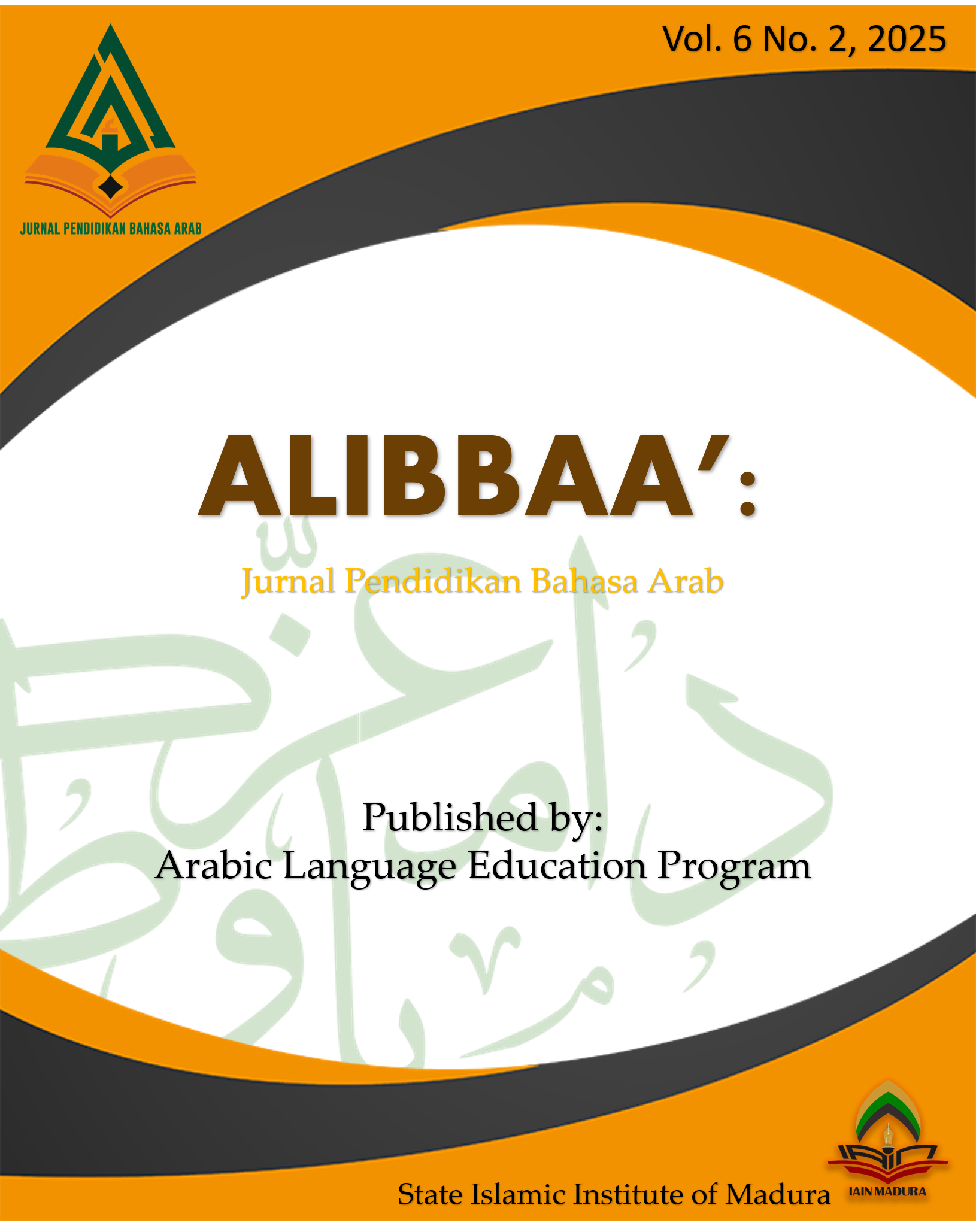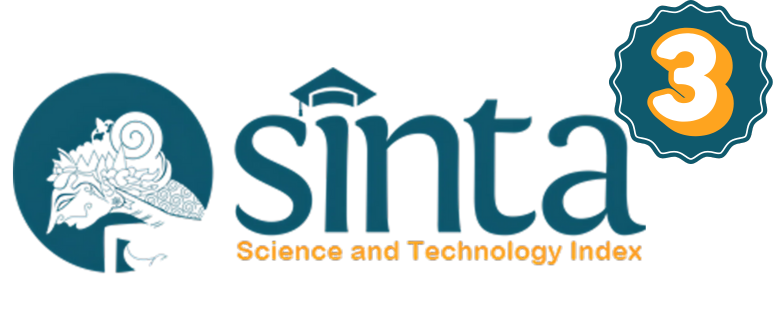Empowering Arabic Reading Skills through Interactive Digital Worksheets: A Development Study Using Liveworksheet
 Abstract views: 170
,
Abstract views: 170
,
 pdf downloads: 154
pdf downloads: 154
Abstract
Despite technological advancements in education, Arabic reading instruction at the elementary level largely relies on conventional methods that hinder student engagement and learning outcomes. This study aimed to develop Arabic reading instructional materials utilizing the Liveworksheet platform to foster active and engaging learning experiences for elementary students. The research employed the ADDIE model, encompassing the stages of Analysis, Design, Development, Implementation, and Evaluation. Conducted at SD Islam Sabilillah Jombang, this study involved 25 fifth-grade students as research participants. The findings demonstrate that the developed materials effectively enhanced students’ reading skills, as indicated by the increase in the average pretest score from 54.04 to 78.08 in the posttest, with an N-Gain score of 0.65, categorized as moderate improvement. The interactive features of Liveworksheet, including drag and drop, multiple-choice, and short-answer activities, successfully promoted active student engagement. This study supports the integration of interactive digital media in Arabic language education and offers a practical solution to improve elementary students’ reading skills.
Downloads
References
Al-Abdullatif, Ahlam Mohammed, and Merfat Ayesh Alsubaie. “Using Digital Learning Platforms for Teaching Arabic Literacy: A Post-Pandemic Mobile Learning Scenario in Saudi Arabia.” Sustainability 14, no. 19 (September 2022): 11868. https://doi.org/10.3390/su141911868.
Allaithy, A., and M. Zaki. “Evaluation of AI-generated Reading Comprehension Materials for Arabic Language Teaching.” Computer Assisted Language Learning, 2025: 1–33. https://doi.org/10.1080/09588221.2025.2474037.
Bouktir, K., A. M. Qahtani, O. Almutiry, H. Dhahri, and A. M. Alimi. “Reduced Annotation Based on Deep Active Learning for Arabic Text Detection in Natural Scene Images.” Pattern Recognition Letters 157 (2022): 42–48. https://doi.org/10.1016/j.patrec.2022.03.016.
Branch, Robert Maribe. Instructional Design: The ADDIE Approach. New York: Springer, 2009.
Dewi, I., Ahmad Nurcholis, Izzatul Laila, Juan Acevedo, and Moumen El-Sayed. “Curiosity-Driven Learning in Arabic: A Case Study on the ‘Inquiring Minds Want to Know’ Approach.” Alibbaa’: Jurnal Pendidikan Bahasa Arab 6, no. 1 (2025): 42–64. https://doi.org/10.19105/ajpba.v6i1.17881.
Faruq, U. “Ta’lim al-Qira’ah li al-Nathiqin bi Ghair al-‘Arabiyyah bi al-Nushush al-Ashliyyah al-Muhtawiyah ‘Ala al-Tsaqafah al-‘Arabiyyah.” Arabiyatuna: Jurnal Bahasa Arab 7, no. 2 (November 2023): 389. https://doi.org/10.29240/jba.v7i2.6621.
Fitriyah, I. J., I. D. Salamah, and U. L. Ramadhan. “The Effectiveness of E-LKPD with a Scientific Approach Using Liveworksheets in Improving Learning Outcomes on the Interaction of Living Things with the Environment.” 030040. https://doi.org/10.1063/5.0215207.
Gharaibeh, M., and A. A. Alhassan. “Role of Teachers in Teaching Arabic Letters to Young Children of UAE: Exploring Criteria of Arabic Letters Teaching.” Cogent Education 10, no. 1 (2023). https://doi.org/10.1080/2331186X.2023.2191392.
Ghannam, J. “Enhancing Independent Learning Competence and Grammar Language Learning Strategies.” In Professional Competencies in Language Learning and Teaching, 31–40. Research-publishing.net, 2019. https://doi.org/10.14705/rpnet.2019.34.912.
Hadi, N., N. Alvina, and Khaled Radhouani. “Ta’zîzu Dâfi’iyyati Thullâbi Riyâdh al-Athfâl li Tathwîri Mahârât al-Lughah al-’Arabiyyah al-Syafawiyyah min Khilâli Barâmiji al-Ta’lîm al-Mukatstsaf.” Alibbaa’: Jurnal Pendidikan Bahasa Arab 5, no. 2 (2024): 189–214. https://doi.org/10.19105/ajpba.v5i2.12195.
Haniff Mohd Tahir, M., I. S. Mohd Ariff Albakri, A. Haimi Mohd Adnan, M. Syafiq Ya Shaq, and D. S. Mohamad Shah. “The Application of Visual Vocabulary for ESL Students’ Vocabulary Learning.” Arab World English Journal 11, no. 2 (2020): 323–338. https://doi.org/10.24093/awej/vol11no2.23.
Huseinović, L. “The Effects of Gamification on Student Motivation and Achievement in Learning English as a Foreign Language in Higher Education.” MAP Education and Humanities 4, no. 1 (2023): 10–36. https://doi.org/10.53880/2744-2373.2023.4.10.
Khuluq, M., M. Hasanah, M. Muasshomah, and N. Imamah. “Mobile-Assisted Language Learning Apps: The Analysis of Duolingo.” Al-Ta’rib: Jurnal Ilmiah Program Studi Pendidikan Bahasa Arab IAIN Palangka Raya 12, no. 2 (2024): 229–246. https://doi.org/10.23971/altarib.v12i2.8806.
Maimunah, I., S. Sutaman, R. Taufiqurrochman, H. H. Siregar, and M. M. I. Alaoui. “Synchronous Arabic Learning Based on Sociocultural Theory: New Trends in Arabic Learning at University.” Arabi: Journal of Arabic Studies 7, no. 2 (2022): 162–172. https://doi.org/10.24865/ajas.v7i2.480.
Mohd Razali, Nornadiah, and Bee Wah Yap. “Power Comparisons of Shapiro-Wilk, Kolmogorov-Smirnov, Lilliefors and Anderson-Darling Tests.” Journal of Statistical Modeling and Analytics 2, no. 1 (2011): 21–33.
Prawijaya, S., F. Rozi, and A. Siregar. “Online Learning Platform Using Canva: An Alternative Experience to Optimize the Learning Process in the Class.” 140002. https://doi.org/10.1063/5.0114111.
Rosyadi, A. M., and M. S. Hidayah. “Penerapan Metode Grammar Translation untuk Baca-Tulis di MA As-Sunniyyah Jember.” Al-Fusha: Arabic Language Education Journal 4, no. 1 (2022): 30–36. https://doi.org/10.62097/alfusha.v4i1.748.
Saiegh-Haddad, Elinor. “MAWRID: A Model of Arabic Word Reading in Development.” Journal of Learning Disabilities 51, no. 5 (2018): 454–462. https://doi.org/10.1177/0022219417720460.
Shortt, M., S. Tilak, I. Kuznetcova, B. Martens, and B. Akinkuolie. “Gamification in Mobile-Assisted Language Learning: A Systematic Review of Duolingo Literature from Public Release of 2012 to Early 2020.” Computer Assisted Language Learning 36, no. 3 (2023): 517–554. https://doi.org/10.1080/09588221.2021.1933540.
Soelistianto, F. A., D. Andrasmoro, Y. Yusriati, M. Mardiati, and A. B. Fawait. “The Impact of Adaptive Learning Technology on Improving Students’ Concept Understanding.” Journal of Computer Science Advancements 2, no. 3 (2024): 158–175. https://doi.org/10.70177/jsca.v2i3.1176.
Subekti, A. R., and L. M. Lestyanto. “Developing the Flipped Classroom Learning Tools Assisted by Liveworksheet on the Topic of Data Presentation.” 030020. https://doi.org/10.1063/5.0194449.
Verawati, A., D. Agustito, W. Pusporini, W. B. Utami, and S. A. Widodo. “Designing Android Learning Media to Improve Problem-Solving Skills of Ratio.” Advances in Mobile Learning Educational Research 2, no. 1 (2022): 216–224. https://doi.org/10.25082/AMLER.2022.01.005.
Yasin, Z., H. Anwar, and B. Luneto. “Multimedia PowerPoint-Based Arabic Learning and Its Effect to Students’ Learning Motivation: A Treatment by Level Designs Experimental Study.” International Journal of Instruction 14, no. 4 (2021): 33–50. https://doi.org/10.29333/iji.2021.1443a.
Yusuf, F., and A. Ali. “Exploring Students’ Perception on Using Live Worksheet as Self-directed Learning of Listening Skills in Online Education.” Utamax: Journal of Ultimate Research and Trends in Education 4, no. 3 (2022): 255–266. https://doi.org/10.31849/utamax.v4i3.11449.
Zaimah, N. R., Risti Kamila Wening Estu, S. F. Hidayah, S. Hadi, and Aiden Button. “Harnessing Gemini for Arabic Mastery: Educators’ and Learners’ Views.” Alibbaa’: Jurnal Pendidikan Bahasa Arab 5, no. 2 (2024): 166–188. https://doi.org/10.19105/ajpba.v5i2.14808.
Zulfa Tsalitsatul Muna, Nur Hidayah, Muhajir, Ashley Le Souef, and Alyssa Devaney. “Mind Mapping as an Innovation in Reading and Writing Learning: A Study of Understanding Arabic Texts.” Alibbaa’: Jurnal Pendidikan Bahasa Arab 6, no. 1 (2025): 120–137. https://doi.org/10.19105/ajpba.v6i1.15963.
Authors who publish with this journal agree to the following terms:
a. Authors retain copyright and grant the journal right of first publication with the work simultaneously licensed under a Creative Commons Attribution License that allows others to share the work with an acknowledgement of the work's authorship and initial publication in this journal.
b. Authors are able to enter into separate, additional contractual arrangements for the non-exclusive distribution of the journal's published version of the work (e.g., post it to an institutional repository or publish it in a book), with an acknowledgement of its initial publication in this journal.
c. Authors are permitted and encouraged to post their work online (e.g., in institutional repositories or on their website) prior to and during the submission process, as it can lead to productive exchanges, as well as earlier and greater citation of published work (See The Effect of Open Access).
Alibbaa': Jurnal Pendidikan Bahasa Arab have CC-BY-SA or an equivalent license as the optimal license for the publication, distribution, use, and reuse of scholarly work.
In developing strategy and setting priorities, Alibbaa': Jurnal Pendidikan Bahasa Arab recognize that free access is better than priced access, libre access is better than free access, and libre under CC-BY-SA or the equivalent is better than libre under more restrictive open licenses. We should achieve what we can when we can. We should not delay achieving free in order to achieve libre, and we should not stop with free when we can achieve libre.

Alibbaa': Jurnal Pendidikan Bahasa Arab is licensed under a Creative Commons Attribution 4.0 International License
You are free to:
- Share — copy and redistribute the material in any medium or format
- Adapt — remix, transform, and build upon the material for any purpose, even commercially.
- The licensor cannot revoke these freedoms as long as you follow the license terms.











